Climate Governance
LITEON works actively to strengthen governance in sustainable development
and sustainable environment. LITEON established a Corporate Sustainability (CS)
Committee directly under the Board of Directors. The CS Committee is chaired
by the board chairman (the Chief Sustainability Officer) and is composed of
five independent directors. It is in charge of setting annual CSR targets in
terms of the economic, environmental, and social aspects of the business.
Progress is monitored regularly to ensure LITEON's continuing advancement
toward sustainability and fulfillment of short-, medium-, and long-term goals.
The CS Committee meets at least twice a year in accordance with LITEON's "Corporate
Sustainability Committee Charter", and regularly reports implementation
plans and results to the Board of Directors.Under the CS Committee there are the
Environmental Sustainability, Risk Management and Sustainable Product Design
subcommittees to improve environmental management efficiency, develop low-
carbon product and manage environmental risks and opportunities.
An Environmental Sustainability subcommittee which is led by the head of
manufacturing, and is responsible for green operations at the plants, setting
environmental targets, risk control, the environmental target achievement
survey. The environmental targets include energy saving plan, GHG emission,
water-saving, waste reduction etc. The subcommittee also analyze the risks and
opportunities from customers, local government and law enforcement.
Sustainable Product Design subcommittee which is led by the head of Research
and Design is responsible for low-carbon design and development.
The Risk Management subcommittee which is led by the head of the operation
identifies environmental risks and opportunities as one of the eight cooperate
risk management according to significance rule. The Subcommittee tracks
risks and opportunities of identification, impact assessment, management
indicator and reports to the CS Committee, Audit Committee and the board of directors.
The Environmental Sustainability subcommittee which is led by the head of
manufacturing, and is responsible for green operations at the plants, setting
environmental targets, risk control, the environmental target achievement
survey. The environmental targets include energy saving plan, GHG emission,
water-saving, waste reduction etc. The subcommittee also analyze the risks and
opportunities from customers, local government and law enforcement.
Climate Risk Management
Risks arising from climate change and natural disaster issues are
included in LITEON's identified categories of sustainability risks. For
the potential impact on business activities, LITEON has the climate
change risk task force in place to handle identification of real and
transformation risks and opportunities, assessment of possibilities, and
analysis of the degree of impact. The task force is also responsible for
devising appropriate countermeasures.
The company conducts climate risk assessment according to the
"ISO 31000 risk management system and guidelines" and convert the
PDCA cycle, converts relevant climate risks into financial figures, and
considers projects that may cause an annual financial impact of more
than NT$10 million as impactful risks and opportunities, which are
prioritized according to likelihood and severity, and corresponding
countermeasures are formulated. For risks with higher assessment
results, a climate scenario analysis is additionally performed, and the current operational layout is considered to calculate its potential
financial impact. Risk assessments are also submitted to the
Sustainability Committee and the Audit Committee for supervision.
The chairman of the Audit Committee regularly reports to the Board of
Directors based on the risk management and assessment results.
LITEON identifies climate-related factors through ongoing improvement
management practices. Measurements are formulated to convert
climate risks into financial data, and countermeasures are devised
to reduce the probability and severity of these risks. The operation
management and results will be submitted to the risk management
team to be reported to the Corporate Sustainability Committee and
the Audit Committee. The chairman of the Audit Committee will in turn
present a report to the board of directors. With respect to challenges
in climate and opportunities, LITEON actively performs climate scenario
analysis specifically targeting higher climate risk factors and calculate
potential financial impacts on an ongoing basis. The practice makes
climate risk management part of business operations.
Climate Strategy
Climate-Related Risks and Opportunities the Organization Has Identified Over the Short-, Medium-, and Long-term
Risks arising from climate change and natural disaster issues are one of LITEON's eight categories of sustainability risks. For the potential impact on business activities, LITEON has the internal climate change risk task force to handle the identification of physical and transition risks and opportunities, assessment of possibilities, and analysis of the influence. The task force is also responsible for devising appropriate countermeasures. In terms of climate risk issues, most major climate risks identified by LITEON came from the requirements of clients, investors, and other important stakeholders for GHG reduction and compliance with product energy efficiency standards. The main climate opportunities are found in the wide range of green products and services that echo sustainability trends.
In 2020, LITEON assessed risks by probability and impact severity, then, identified that the company might be impacted by net-zero emissions commitments made by EU and Chinese economies and key clients. These commitments may prompt them to impose low carbon or even zero carbon emissions requirements on the company's operation and push up production costs. LITEON pays a lot of the attention to the potential financial implications of climate change risks. The company follows a risk management process and the PDCA cycle to monitor climate risks. Measurements are formulated to convert climate risks into financial data, and countermeasures are devised to reduce the probability and severity of these risks. The operation and results will be submitted to the risk management team to be reported to the Corporate Sustainability Committee and the Audit Committee.
The chairman of the Audit Committee will in turn present a report to the board of directors. LITEON adopts a positive attitude to challenges in climate risks and opportunities. The company will perform climate scenario analysis specifically targeting higher climate risk factors and calculate potential financial impacts on an ongoing basis. The practice makes climate risk management part of the business operations.
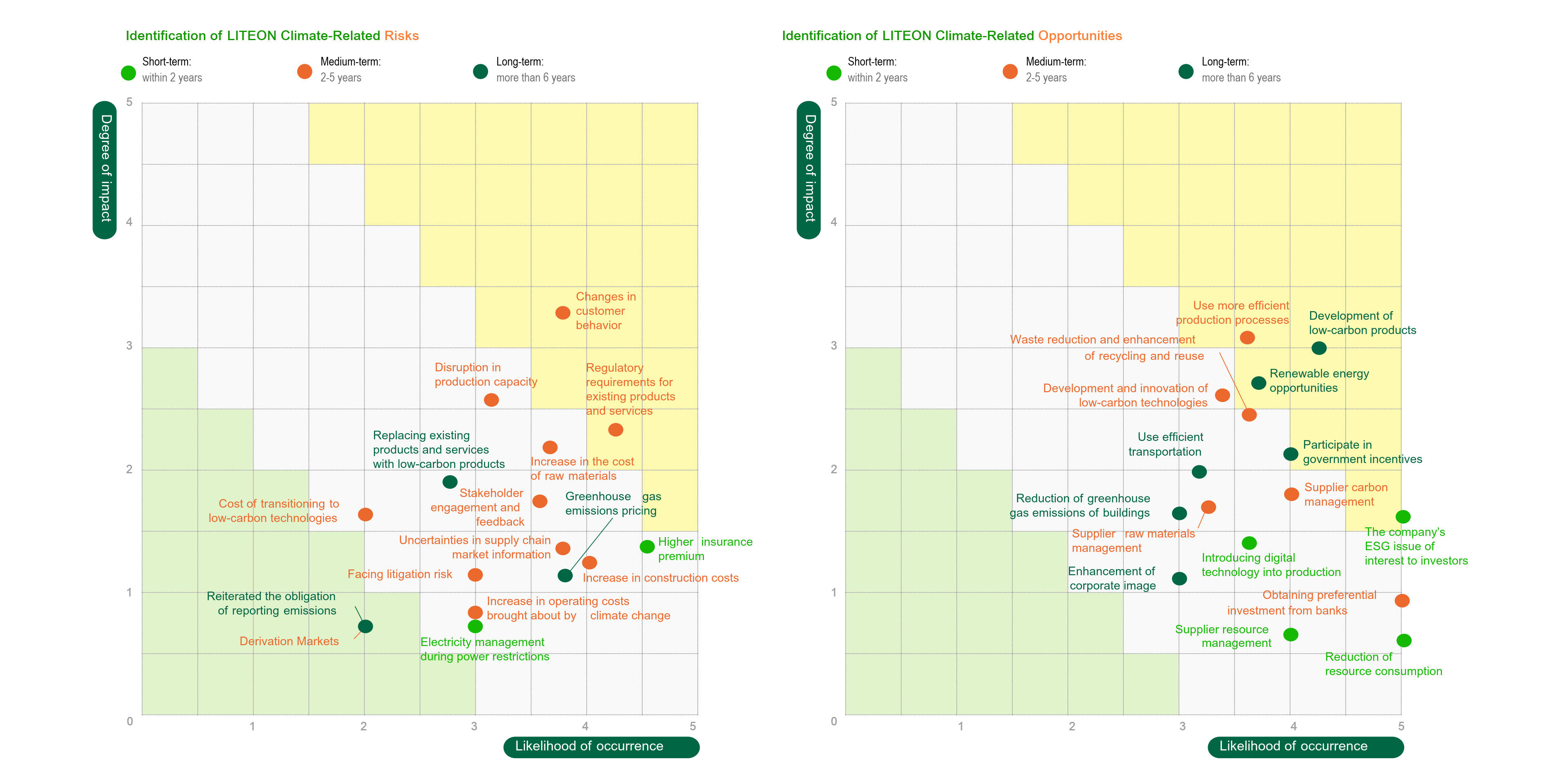
Climate Risk Identification
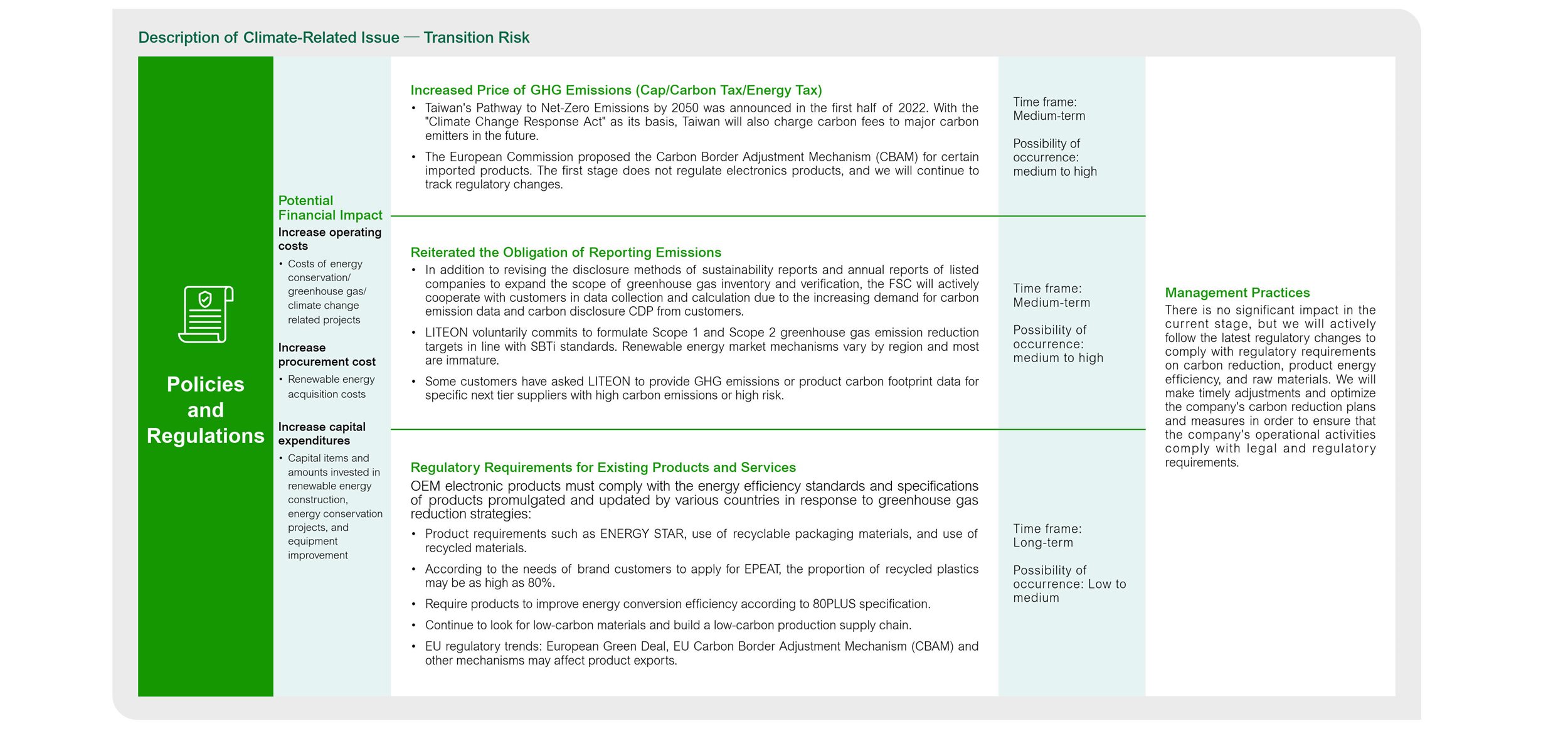
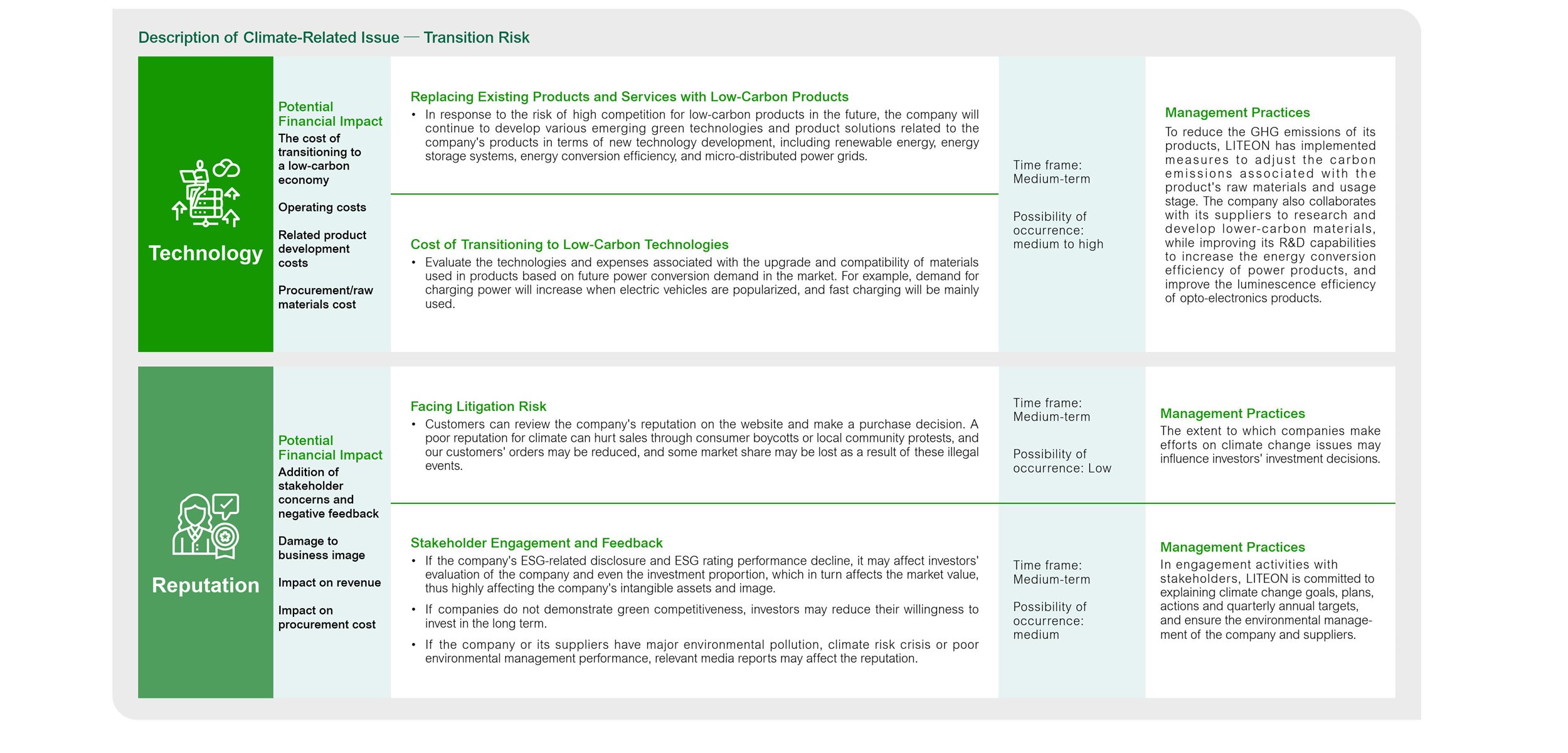
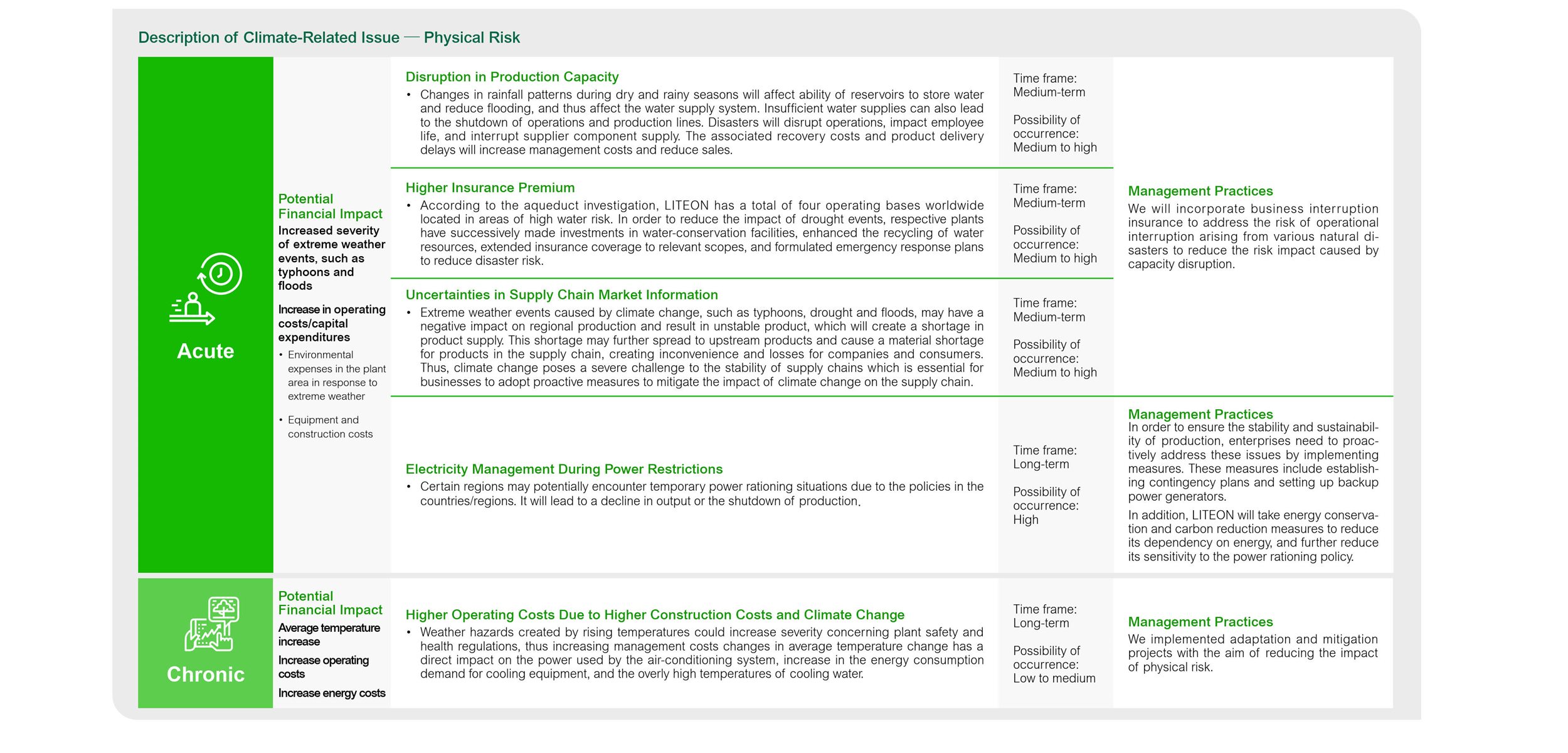
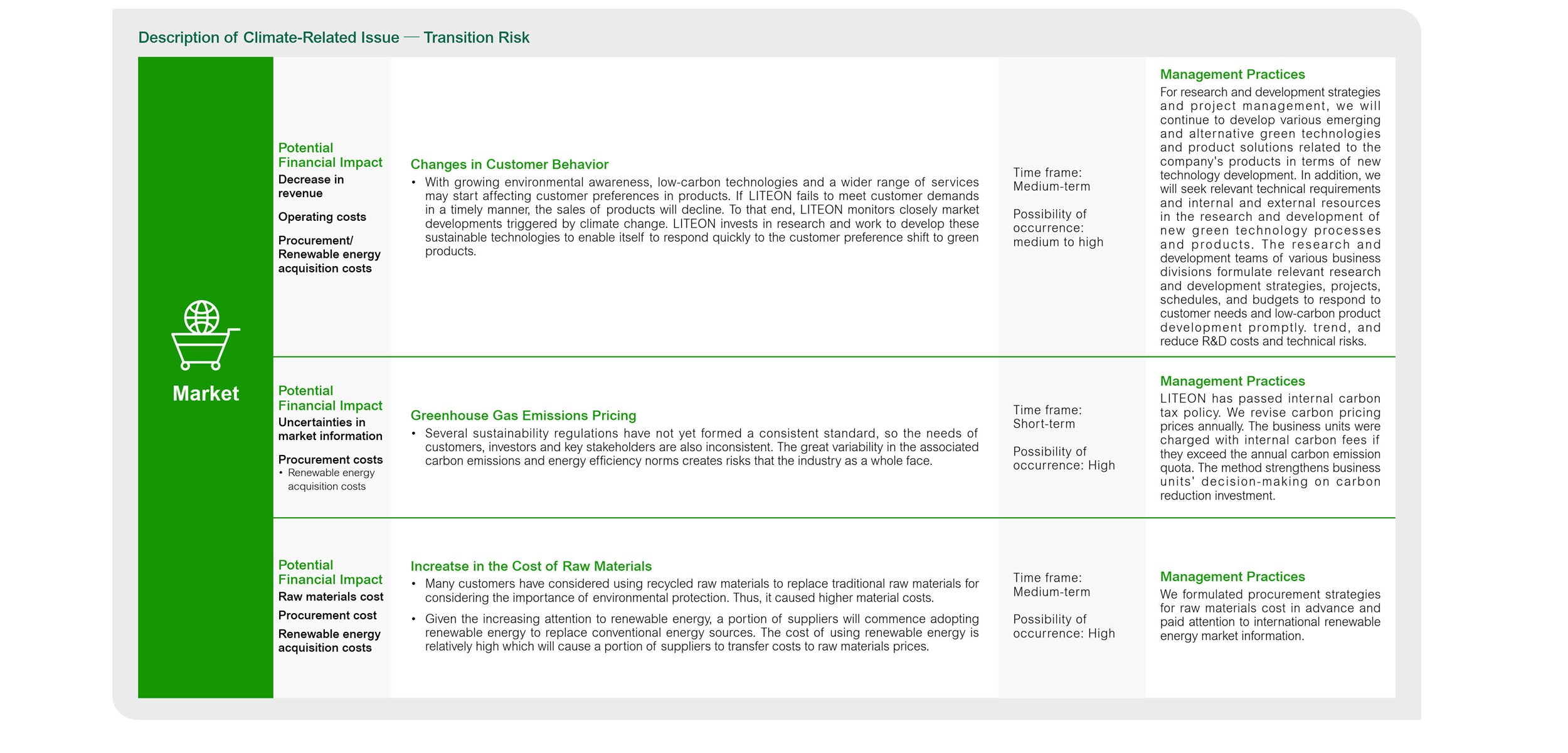
Climate Opportunity Identification
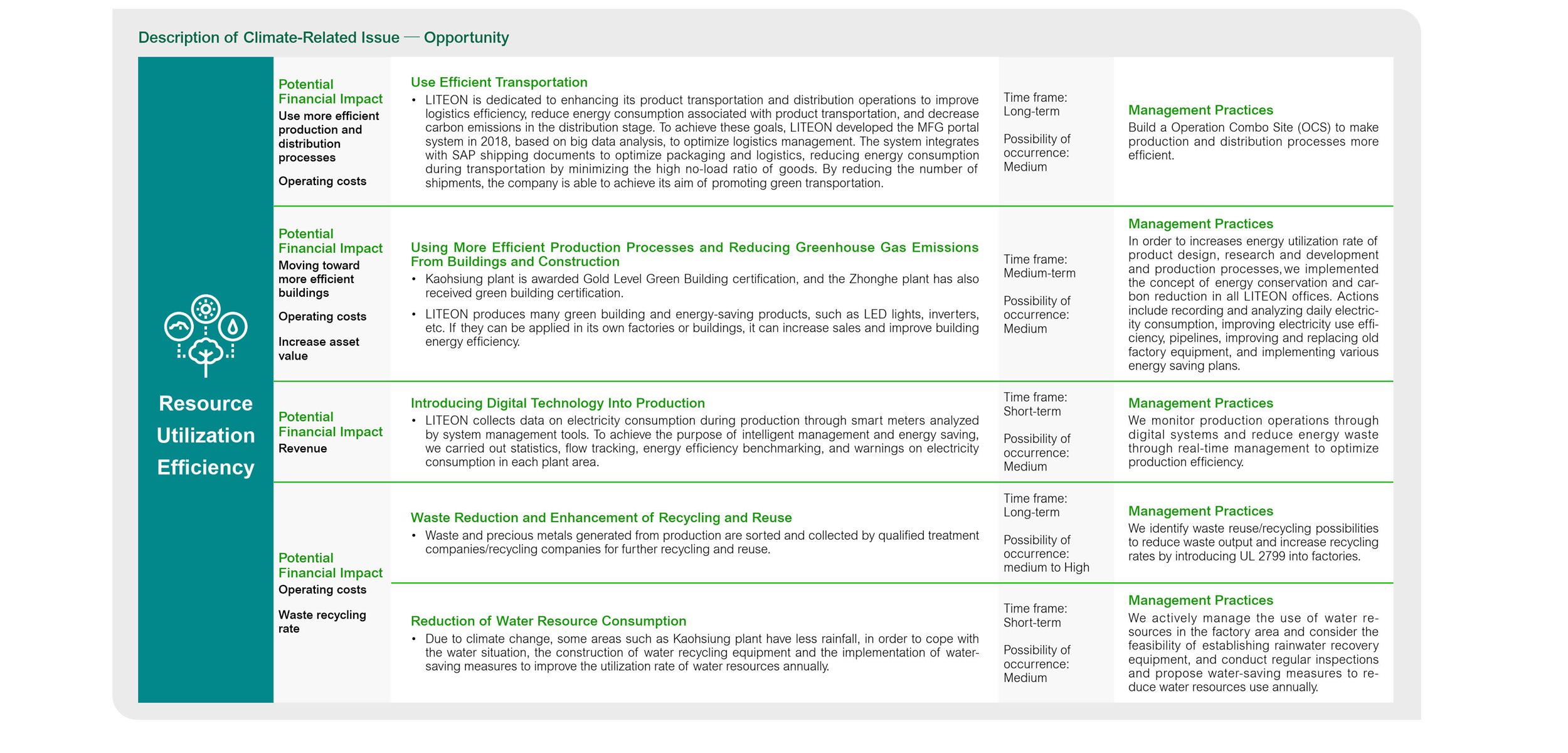
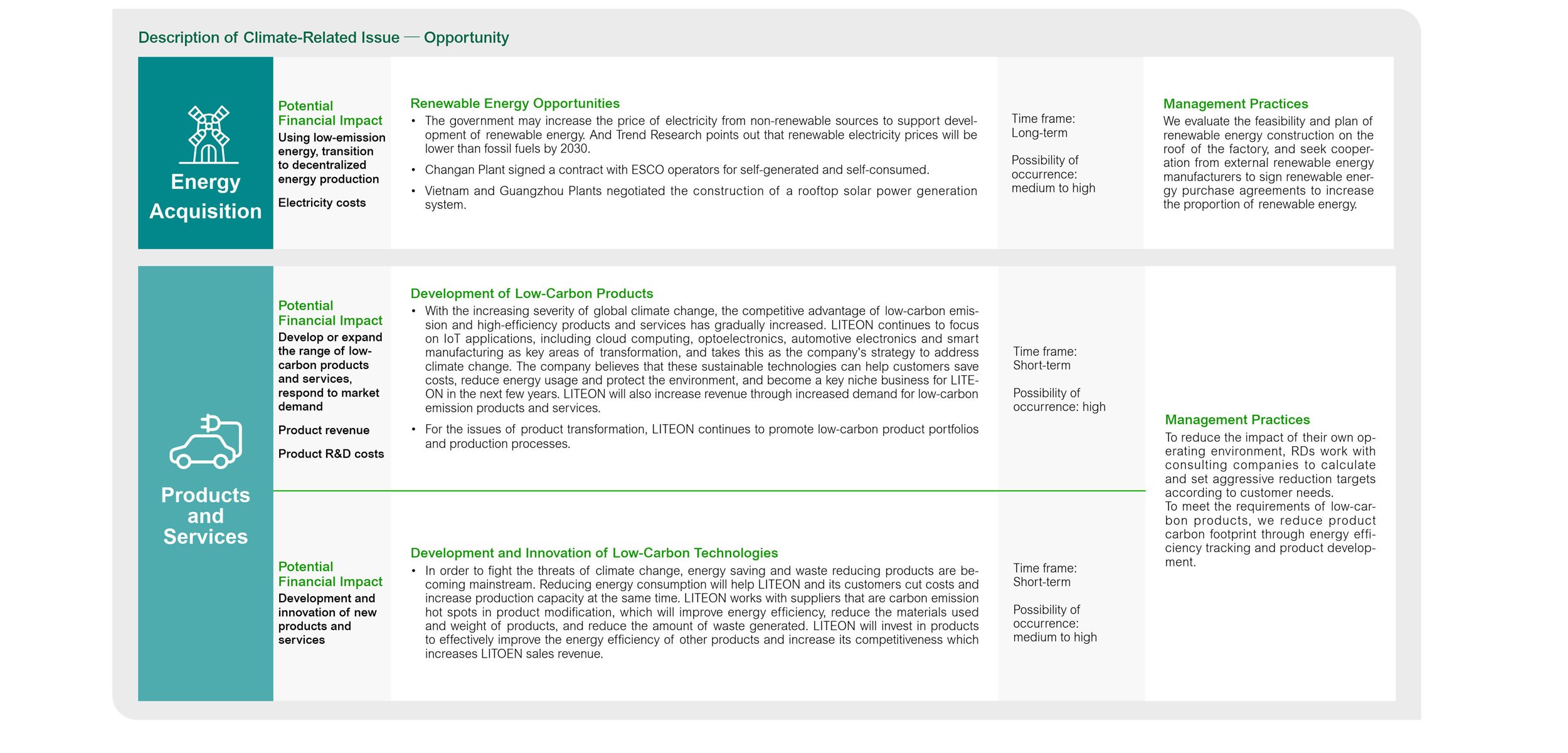
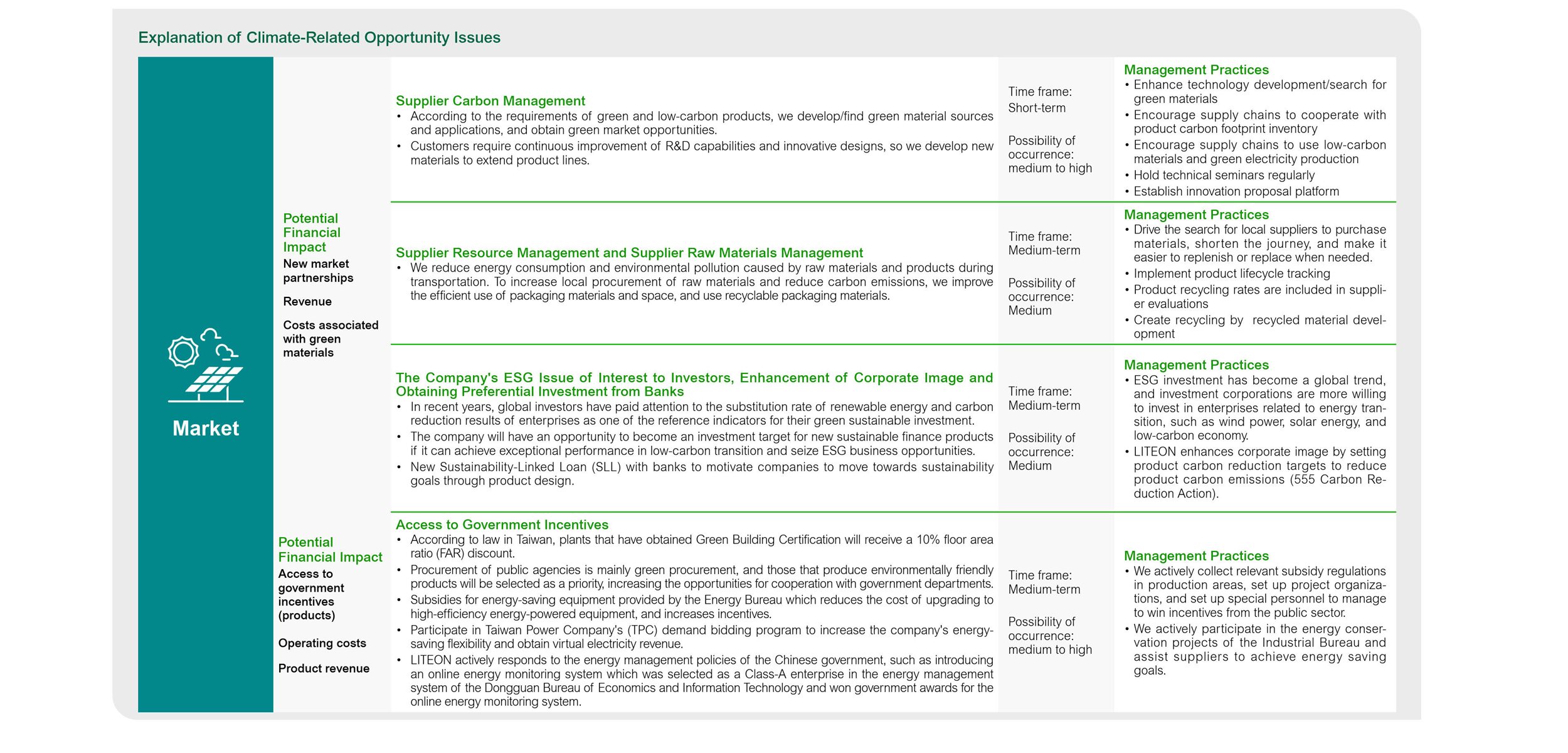
Climate Risk Management and Financial Impact Assessment
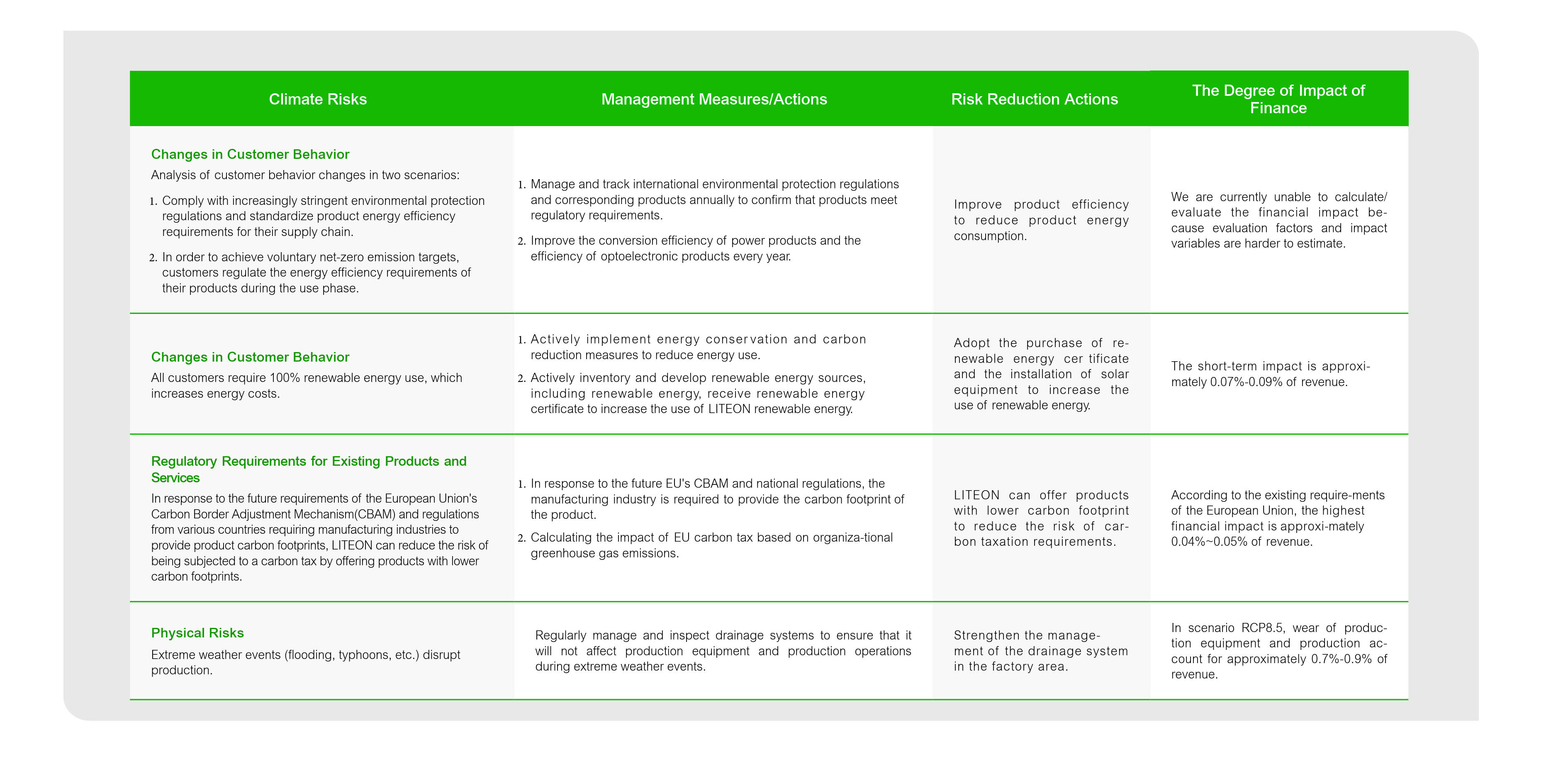
Climate Change Mitigation and Adaptation Measures
Enhanced renewable energy utilization
LITEON is committed to increasing the utilization rate of renewable
energy and reducing its carbon emissions. The company achieves
this by increasing the amount of renewable energy it uses and the
proportion of renewable energy in its energy mix year by year. LITEON
accomplishes this by reducing its energy use, installing rooftop solar
power systems, and procuring International Green Electricity Certificates.
The company is dedicated to achieving low-carbon production and is
actively seeking out renewable energy companies to sign long-term
green power purchase agreements (PPAs). In 2022, LITEON has already
used and purchased renewable energy certificates. The company's
renewable energy consumption using I-REC has reached 88,945 MWh,
accounting for 26.8% of its total electricity consumption.
| | 2017 | 2018 | 2019 | 2020 | 2021 | 2022 |
| Renewable Energy Consumtion(mwh) | 15,385 | 20,447 | 45,062 | 57,098 | 74,672 | 88,945 |
| RE percetage | 3.61% | 5.05% | 13.08% | 16.53% | 19.79% | 26.8% |
Energy management
LITEON continues to improve the efficiency of energy use, improves
equipment and adopts different energy-conservation methods in
energy use; it increases production output while saving energy,
improving production efficiency. In 2022, a total of 6 production sites
will continue to operate under the ISO 50001 energy management
system. We expect to increase the number of ISO 50001 production
sites in 2023 and to cooperate with energy-conservation plans to
reduce electricity consumption for production and improve production
efficiency. It established a demonstration site for the implementation
of the process pilot plan, introduced power analysis tools, digitized
the power consumption of intangible processes, generated a power
model of the utility and process system and the power consumption
analysis diagrams of production processes, find out the optimal control
scheme for power consumption, and improve efficiency of energy use.
In 2022, a total of
72 energy-conservation plans were implemented, with a total energy
savings of 24,440 MWh. Among them are primarily the air-compressors
and air-conditioner/chiller and process equipment, accounting for 70%
of the total energy savings.
Enforcing GHG emissions reduction
LITEON develops production optimization and plant operation improvement, and
continues to reduce energy by promoting diversified energy-saving plans. The plans
included updating air compressors, adopting high-efficiency equipment, improving
and managing processed equipment technology and introducing management
system and other energy-saving plans. energy saving and operational equipment
efficiency improvement. Many sites implemented the pressure adjustment of air
compressor equipment to reduce energy use. It is executed at LITE-ON
Electronics (Dongguan), LITE-ON Technology (Vietnam), LITE-ON Electronics
(Guangzhou) and other production sites. LITEON upgraded the air compressor
Equipment efficiency by reducing the outlet pressure. For 2023, LITEON has
outlined 42 energy-saving measures and plans to reduce electricity
consumption by around 15,000 MWh..
Strengthened internal carbon pricing strategy
LITEON continues to actively adjust the governance aspects related to sustainable
operations and sustainable environment. It has established an Environmental
Sustainability subcommittee, which is chaired by the head of manufacturing.
The subcommittee is responsible for promoting green operations to improve
environmental management performance and environmental risk controls. In
2018, LITEON referred to relevant regulations on carbon trading in Taiwan and the
market price of carbon trading in China, and adopted the shadow price method to
set the carbon fee price as the decision-making for our energy-saving and carbon-
reduction measures. In addition to the overall SBT carbon reduction target, LITEON
also sets the SBT emission intensity target, and determines an internal carbon
price to replace the shadow price every year starting from 2020. In 2022, a carbon price of 1 USD/ton of carbon dioxide equivalent was maintained, and the business units were subjected to internal carbon fees in case they exceeded their annual carbon emission quota.
The method strengthens business units' decision-making on carbon reduction
investment, and it expect to gradually increase the fee in the future as an investment
in carbon reduction technology or to support renewable energy work to achieve
LITEON's carbon reduction commitment.
Develop low carbon products
The LITEON CSR code of conduct is based on life cycle thinking. With the 3Rs rule
adopted, the company engages in green product design and develops nontoxic,
easy to assemble/disassemble, and environmentally friendly products. For example,
the optimized circuit design improves the energy conversion efficiency of power
products (power supplies for servers and 3C products etc.), reduces energy
consumption, material consumption and carbon emissions. In LED and energy-
saving street light products, energy consumption is reduced by improving energy
efficiency and light extraction efficiency. Furthermore, by using low-carbon recycled
materials, improving packaging technology, and extending product life, based on
shipments in 2022, the overall reduction of carbon emissions in the product use
phase is approximately 493,749.6 tons. The cumulative carbon reduction due to the
green product design reached 504,580 tons of CO2e . Please see Green Product Management for more information.
Environmental Sustainability ▸
Top
Select Language










